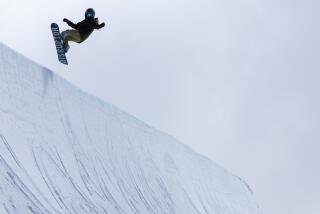Ski Bikes Are Great on the Slopes, but Forget the Wheelies
Snowboarders and skiers lately are being joined on the slopes by ski bikers, who ride a strange-looking version of a bike on a ski and wear a short ski on each foot. The sport is an increasingly popular option for baby boomers with ski-battered knees and for cutting-edge youths looking for new ways to conquer the mountain.
At least 34 U.S. ski resorts welcome ski bikers, says Rod Ratzlaff, director of the American Ski-Bike Assn.,
www.ski-bike.org. Ratzlaff, who lives outside Lake George, Colo., founded the nonprofit group last year to promote the sport. “It’s a lot easier on your body” than downhill skiing, he says. In fact, “creaky knees and leg endurance that isn’t quite what it used to be” helped drive him to the sport after 30 years of skiing, he says.
Using techniques similar to downhill skiers’, ski bikers carve turns in the snow to control their descent; there are no brakes, so they must turn to stop. Ski bikers have been clocked at up to 114 mph, Ratzlaff says. But most recreational bikers go 25 to 30 mph, slightly slower than the typical skier, says Nicky Deford, spokeswoman for Vail Mountain in Colorado. She recommends the sport for strong intermediate skiers.
Vail offers five nighttime guided tours that are “incredibly popular,” Deford says. Priced at $55 per person for 2 to 21/2 hours of biking, they are always sold out, she says; reservations two to three days in advance are advised.
Some resorts, such as Vail, ban bikers in the daytime, but Bear Mountain, Northstar at Tahoe and Sierra at Tahoe are among the California resorts that welcome ski bikers. Ratzlaff says rentals typically are $15 to $45 per day and that the bikes cost $600 to $1,600 each. His Web site lists welcoming resorts, with links to their Web sites and to ski bike manufacturers.
The sport, developed in Europe, was briefly popular in the U.S. in the 1960s and ‘70s, then faded until its recent revival, Ratzlaff adds.
More to Read
Sign up for The Wild
We’ll help you find the best places to hike, bike and run, as well as the perfect silent spots for meditation and yoga.
You may occasionally receive promotional content from the Los Angeles Times.





